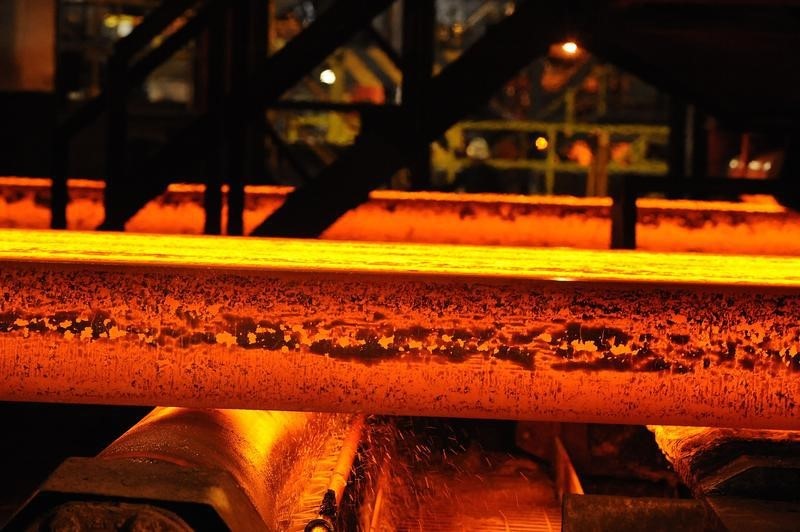By Andy Home
LONDON (Reuters) – China’s appetite for base metal imports appears to be growing.
Refined volumes hit a year-to-date monthly high in August and primary aluminium imports were the highest since November 2021.
The country has also fully reverted to being a net importer of unwrought zinc after flipping to net exporter in 2022.
Rising imports are flowing through an open arbitrage window resulting from Shanghai Futures Exchange (ShFE) prices outperforming the London Metal Exchange (LME).
While LME forward curves are in contango, cash is commanding a premium in Shanghai due to low visible exchange inventory.
Higher imports would seem to fit the bullish narrative that the Chinese government’s piecemeal stimulus programme is gaining traction and the world’s largest buyer is recovering its metallic mojo.
However, robust copper and aluminium imports come with important caveats and the broader metals trade picture is far more mixed.
FROM RUSSIA WITH LOVE
China’s imports of primary aluminium surged to a near two-year high of 153,000 metric tons in August, bringing the year-to-date count to 755,000 metric tons. Last year’s equivalent tally was just 298,000 metric tons.
However, just about all the metal being imported is Russian-brand. Imports of Russian aluminium accounted for 87% of the total in the first eight months of 2023.
Is the headline acceleration in imports down to demand pull or supply push?
Russian aluminium is not officially sanctioned but the U.S. market has been effectively closed by penal 200% import duties and many Western consumers are self-sanctioning by opting for different origin metal.
China is clearly soaking up a large part of this displaced metal and it appears to be doing so at a discount.
The average value of Russian imports was $2,162 per metric ton in August, compared with $2,279 for Malaysian-brand metal and $2,355 for both Australian and New Zealand imports.
Without the Russian push, would China’s aluminium imports look so impressively robust?
SLOW COPPER BOAT TO SHANGHAI
Refined copper imports were 340,000 metric tons in August, the highest monthly tally this year.
However, cumulative imports of 2.29 million metric tons are still down by 8% on last year and net imports are down by 10% due to slightly higher exports in 2023 relative to 2022.
The mini-surge also has much to do with Democratic Republic of Congo (DRC). Imports of copper from DRC have accelerated sharply from 57,000 metric tons in June to 74,000 in July and an all-time record 97,000 in August.
These are catch-up shipments from China’s CMOC Group, which was blocked from exporting between June last year and April this year during a prolonged stand-off with the government over taxes.
CMOC, which produced 254,000 metric tons of refined copper last year, began shipping from its stockpile in June with the metal evidently starting to arrive in China in July and August.
Imports of copper from DRC have accounted for more than 25% of total inbound shipments in the last two reported months and have kicked the headline figure higher.
ZINC BUSINESS AS USUAL
China was a net exporter of refined zinc last year for the first time since 2007. Western smelter outages sent physical premiums sky-high, sucking metal out of China as the supplier of last resort.
The country’s refined zinc trade has reverted to net imports this year but volumes remain modest by historical standards.
Net imports of 199,000 metric tons over the first eight months of the year were, barring last year, the lowest since 2010.
Moreover, imports of 29,000 metric tons in August itself were sharply off the pace of the 77,000 recorded in July. The next few months will tell whether zinc imports will return to the levels seen over the last decade.
SHIFTING THE NICKEL MIX
There has been no pick-up in China’s imports of refined nickel. Indeed, they’ve been declining steadily since the start of last year.
They’ve fallen another 50% to 48,000 metric tons over the first eight months of 2023.
China’s electric vehicle battery manufacturers don’t need so much nickel in this form as they pivot to increased flows of intermediate products coming from Indonesia.
Indonesian shipments of ferronickel grew by 51% in the first eight months of this year. Those of intermediate products and nickel matte were up by 92% and 138% respectively.
Imports of Indonesian nickel sulphate only began in May but have already grown to 25,000 metric tons, accounting for 38% of total year-to-date arrivals.
The share of refined metal in China’s import mix is continually shrinking and with many Indonesian producers still ramping up new capacity that trend seems likely to run.
ALL CHANGE IN LEAD?
China has been a significant exporter of refined lead since the middle of 2021, when, similar to sister metal zinc, smelter problems in the West caused physical premiums to soar.
However, unlike their zinc peers, China’s lead producers are still exporting to the tune of a net 101,000 metric tons in the first eight months of 2023.
That was up by 10% on the same period last year and begs the question as to whether this is the new norm in terms of global flows of unwrought lead.
The opinions expressed here are those of the author, a columnist for Reuters.
Read the full article here










